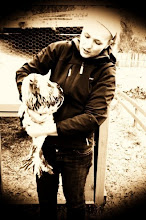
Thanks to school finals, my posts on here have been non existent. Even now, I should be studying for my anthropology final tonight, but my brain is feeling a little saturated. So, information in, information out:
Despite my ongoing ramblings about raising and growing my own food, I am actually more interested in the wild foods that grow all around us without human aid. For 90 percent of human history we have been foragers, and anthropological studies show that this is the healthiest and most leisurely type of subsistence that exists. Forget your caveman stereotypes. Until that first group exceeded carrying capacity and created the monster that is intensive agriculture, foraging was heaven on earth.
When I was a kid, certain wild foods were acceptable to eat like blackberries and honeysuckle, and I definitely ate more than my fair share of these every summer. Other wild foods, like strawberries, were off the list according to mom who said these were poisonous (they're not..eat up). Later as a teenager, my sister and I found my parent's Field Guide to North American Edible Wild Plants (Elias and Dykeman), which we carried along on camping trips but never really tried using it. Also around that time, my sister gave me the book Identifying and Harvesting Edible and Medicinal Plants ("Wildman" Steve Brill), but it wasn't until about 4 years ago that I actually read it. It's a great book for the beginner, and is still a valuable reference in my library. Since then, I've accumulated a number of wild food field guides (Peterson's is the best) and some wild food classics like Stalking the Wild Asparagus by wild foods guru Euell Gibbons. These books are all great starts to learning how to eat well and for free.
It's truly amazing how much variety grows right outside your door. Not including the vegetable garden, here are some of the edibles in my yard: broad leaf plantain, sword leaf plantain, chickweed, day lilies, white clover, mulberry, violets, dandelion, wood sorrel, juniper berries, chokeberry, hawthorn, yucca, redbud, blueberries, bee balm, lemon balm, various mints, Jerusalem artichoke, rose, spiderwort, poke weed, sow thistle, hen-bit, cattail, prickly pear, burdock, sage, rosemary, lavender, lambs quarters, lady's thumb, mallow, yarrow, wild onions, peach, and apple.
Right now the mulberries are ripening, and it's a race against the mockingbirds and robins to eat them. Richmond is full of these trees, and sadly most people seem to regard them as a messy nuisance. When I look at them, I think "YUM" and "FREE." Picked when just barely ripe, the fruit is firm and tastes much like a cherry. Picked when very ripe, the berries are much sweeter and extremely fragile and juicy. Eat them straight from the tree, or use in jams, muffins, pancakes, cobblers, etc. This year, I'm thinking about freezing some of the firmer fruits for use in the winter. I'm going to load up now, and by the time the mulberries are just about done, the wild blackberries will be just about ready.
Below: Pictures from last year's mulberry eatin'. I didn't do such a hot job on the pie lattice, but it was still delicious.


*Important! You should never NEVER try any wild foods that you are not 150 percent sure of it's identity and edible parts. Without that knowledge being passed down from generation to generation, it's easy for a novice to make a deadly mistake.

No comments:
Post a Comment